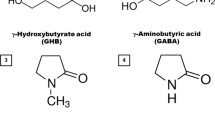Abstract
Valerena-4,7(11)-diene and β-maaliene were isolated from spikenard for the first time, and the effects of inhaling these compounds were investigated. Both compounds reduced the locomotor activity of mice dose-dependently, even at a low dose. Valerena-4,7(11)-diene had a particularly profound effect, with the strongest sedative activity observed at a dose of 0.06%. Caffeine-treated mice that showed an area under the curve (AUC) for locomotor activity that was double that of controls were calmed to normal levels by administration of valerena-4,7(11)-diene. The continuous sleep time of pentobarbital-treated mice was prolonged by about 2.7 times with valerena-4,7(11)-diene, an effect similar to that of chlorpromazine administered orally.






Similar content being viewed by others
References
Touhara K, Sengoku S, Inaki K, Tsuboi A, Hirono J, Sato T, Sakano H, Haga T (1999) Functional identification and reconstitution of an odorant receptor in single olfactory neurons. Proc Natl Acad Sci USA 96:4040–4045
Komori T, Matsumoto T, Motomura E, Shiroyama T (2006) The sleep-enhancing effect of valerian inhalation and sleep-shortening effect of lemon inhalation. Chem Senses 31:731–737
Hiroaki T, Michiho I, Tomohiro S, Toru Y, Gisho H (2008) Sedative effects of vapor inhalation of agarwood oil and spikenard extract and identification of their active components. J Nat Med 62:41–46
Harada H, Eura Y, Shiraishi K, Kato T, Soda T (1998) Coherence analysis of EEG changes during olfactory stimulation. Clin Electroencephalogr 29:96–100
Buechi G, Greuter F, Tokoroyama T (1962) Terpenes. XVII. Structure of calarene and stereochemistry of aristolene. Tetrahedron Lett 3:827–833
Paul C, König WA, Muhle H (2001) Pacifigorgianes and tamariscene as constituents of Frullania tamarisci and Valeriana officinalis. Phytochemistry 57:307–313
Matsuo A, Nozaki H, Kataoka H, Nakayama M, Hayashi S (1979) (−)-Maalian-5-ol, a new enantiomeric sesquiterpenoid from the liverwort Plagiochila ovalifolia. Experimentia 35:1279–1280
Houghton P (1994) Herbal products: valerian. Pharm J 253:95–96
Koo BS, Park KS, Ha JH, Park JH, Lim JC, Lee DU (2003) Inhibitory effects of the fragrance inhalation of essential oil from Acorus gramineus on central nervous system. Biol Pharm Bull 26:978–982
Screening information data set for high volume chemicals (2007) United Nations Environment Programme (UNEP) http://wwwchem.unep.ch/irptc/sids/oecdsids/sidspub.html. Accessed 15 Feb 2009
Rasch B, Büchel C, Gais S, Born J (2007) Odor cues during slow-wave sleep prompt declarative memory consolidation. Science 9(315):1426–1429
Sinha D, Efron D (2005) Complementary and alternative medicine use in children with attention deficit hyperactivity disorder. J Paediatr Child Health 41:23–26
Acknowledgment
This work was supported in part by the Takeda Science Foundation (For M. Ito, 2007).
Author information
Authors and Affiliations
Corresponding author
Rights and permissions
About this article
Cite this article
Takemoto, H., Yagura, T. & Ito, M. Evaluation of volatile components from spikenard: valerena-4,7(11)-diene is a highly active sedative compound. J Nat Med 63, 380–385 (2009). https://doi.org/10.1007/s11418-009-0340-x
Received:
Accepted:
Published:
Issue Date:
DOI: https://doi.org/10.1007/s11418-009-0340-x




